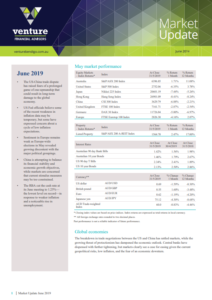The Pulse

- The US-China trade dispute has raised fears of a prolonged game of one-upmanship that could result in long-term damage to the global economy.
- US Fed officials believe some of the recent weakness in inflation data may be temporary, but some have expressed concern about a cycle of low inflation expectations.
- Sentiment in Europe remains weak as Europe-wide elections in May revealed growing discontent with the major political groupings.
- China is attempting to balance its financial stability and economic growth objectives, while markets are concerned that current stimulus measures may be too constrained.
- The RBA cut the cash rate at its June meeting to 1.25%—the lowest level on record—in response to weaker inflation and a noticeable rise in unemployment.
Global Economies
The breakdown in trade negotiations between the US and China has rattled markets, while the growing threat of protectionism has dampened the economic outlook. Central banks have dispensed with further tightening, but markets clearly see a case for easing given the current geopolitical risks, low inflation, and the fear of an economic downturn.
Australia
Market expectations for a cut in interest rates were satisfied in June as the RBA decided to lower the cash rate by 25 basis points to a record low 1.25%. The outlook remains broadly unchanged with the Australian economy expected to grow by 2.75% in both 2019 and 2020, but the RBA noted its intention is to provide additional support to the labour market and ensure that inflation
expectations can be sustained.
US
The US economy seems to have settled back towards a more sustainable growth path. The March quarter GDP result of 3.1% overstates the underlying position of the economy, but the Atlanta Fed’s GDP now of just 1.2% growth for the June quarter likely understates the true picture.
Europe
Europe is battling low inflation and falls in manufacturing activity, with some small signs of improvement overshadowed by trade fears and a tense Europe-wide election.
China
Recent economic data has broadly undershot expectations, with the May manufacturing PMI slipping from 50.1 to 49.4 (lower than the expected 50.0) and April industrial production easing to 5.4% after spiking to 8.5% in March.
Asia Region
The latest PMI data showed further weakness in Japan’s manufacturing economy, with output falling for the fifth consecutive month in May and both domestic and international demand declining.